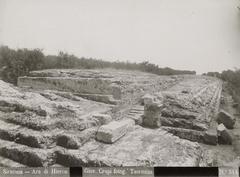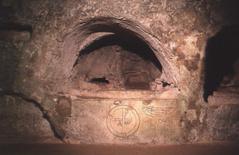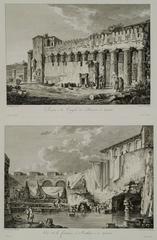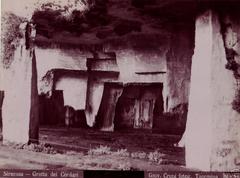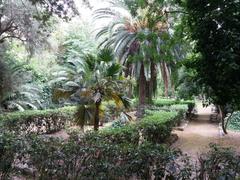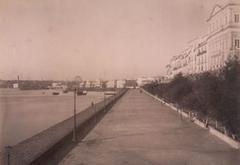Torre Landolina Visiting Hours, Tickets, and Guide to Syracuse Historical Site
Date: 14/06/2025
Introduction to Torre Landolina in Syracuse
Situated in the heart of Ortigia, the historic center of Syracuse, Sicily, Torre Landolina stands as a testament to the city’s layered history and aristocratic legacy. This fortified tower, which seamlessly integrates medieval defensive features with Baroque embellishments, offers visitors a unique perspective on the evolution of Syracuse—from its ancient Greek foundations to its Renaissance and Baroque flourishes. Its proximity to significant landmarks such as Piazza Duomo and the Cathedral of Syracuse positions Torre Landolina as an essential stop for those exploring the rich cultural tapestry of the city.
Originally constructed as part of the Landolina family’s noble complex during the late medieval or early modern period, the tower reflects the strategic and social importance of aristocratic residences within Syracuse. Its robust stone walls, narrow windows, and decorative balconies embody both defensive utility and refined domesticity, mirroring the city’s adaptation through successive cultural epochs, including Norman, Byzantine, and Spanish rule.
Public access to Torre Landolina is typically limited, generally available during special events or organized guided tours. Nevertheless, its striking exterior and central location make it an unmissable landmark amid Ortigia’s charming streets. This guide provides comprehensive visitor information, including current visiting hours, ticket options, accessibility, architectural highlights, ongoing restoration efforts, and practical travel tips. Whether you are a history enthusiast, architecture lover, or casual traveler, you’ll find valuable insights to enhance your experience at Torre Landolina and throughout Syracuse’s historic core.
For the latest visiting hours and ticket details, consult official resources such as the Syracuse Tourism Office and the Visit Sicily Official Site. Additional historical background can be found on platforms like Great Sicily and Living Nomads.
Table of Contents
- Introduction
- Historical Background and Architectural Evolution
- Visiting Hours, Tickets, and Accessibility
- Practical Visitor Information and Travel Tips
- Architectural Features and Restoration Efforts
- Cultural and Historical Significance
- Integrating Torre Landolina into a Syracuse Itinerary
- Frequently Asked Questions (FAQ)
- Visuals and Media
- Conclusion and Recommendations
- References and Further Reading
Historical Background and Architectural Evolution
Torre Landolina was constructed during Syracuse’s late medieval to early modern period, a time marked by the city’s transformation under various ruling powers. The tower originally formed part of the palatial complex belonging to the influential Landolina family, whose prominence left an indelible mark on the city’s cultural and civic life.
Architecturally, the tower merges the defensive solidity typical of medieval fortifications—thick stone walls, narrow windows, and strategic vantage points—with the ornamental sensibility of Baroque design, particularly evident in the adjoining palazzo. The palazzo itself was significantly remodeled following the devastating 1693 earthquake, incorporating ornate balconies and frescoed interiors that contrast with the austerity of the tower. Over the centuries, Torre Landolina served both as a private residence and a social hub for intellectuals and dignitaries.
Visiting Hours, Tickets, and Accessibility
Visiting Hours
- General Access: Torre Landolina is privately owned and public entry is limited. Access is typically granted during special events, cultural exhibitions, or as part of guided tours.
- External Viewing: The tower can always be admired from the surrounding streets of Ortigia.
- Up-to-date Information: Check the Syracuse Tourism Office or local cultural event listings for specific opening dates.
Tickets
- Admission Fees: When open for special events or tours, a ticket may be required. Prices and availability depend on the event and tour operator.
- Purchase Options: Tickets can generally be booked online through official tourism websites or purchased at local ticket offices in Ortigia.
Accessibility
- Physical Access: Owing to the tower’s age and design, accessibility is limited, especially for visitors with mobility impairments. The surrounding Ortigia area, however, is largely pedestrian-friendly.
- Accommodations: Contact tour organizers in advance to discuss any needed accommodations.
Practical Visitor Information and Travel Tips
- Location: Torre Landolina is centrally located in Ortigia, within easy walking distance of major attractions like the Duomo di Siracusa and Fonte Aretusa.
- Getting There: Parking is scarce near the tower. Utilize public parking lots at Ortigia’s edge or use public transportation and taxis for convenience.
- Best Visiting Times: Spring (April–June) and early autumn (September–October) offer mild weather and fewer crowds.
- Amenities: The area is well-served with cafés, restaurants, and shops. Families will find the locale welcoming, with child-friendly attractions and accommodations such as Corte Landolina.
Architectural Features and Restoration Efforts
Architectural Highlights
- Structure: Typical of Sicilian fortified towers, Torre Landolina has a square plan (approx. 6.55m per side) and stands about 13.45m high over three floors, each accessed by internal stairs.
- Materials: Constructed primarily of irregular stone masonry with reinforced limestone corners, covered by protective plaster.
- Design Elements: The north facade features an arched cornice and 19th-century decorative motifs, stone-framed balconies, and distinctive window arrangements, including a blocked upper window hinting at historical changes.
- Interior: Preserved wooden beams and a simple, functional layout reflect its dual defensive and residential functions.
Restoration Efforts
- Principles: Restoration projects emphasize preservation of original materials, minimal intervention, and reversibility of modern updates.
- Recent Work: Focus areas include masonry consolidation, renewal of external plaster with lime-based materials, and conservation of stone elements.
- Sustainability: Efforts incorporate breathable materials and improved insulation to ensure both longevity and visitor comfort.
- Challenges: Balancing historical authenticity with modern usability and compliance with heritage protection laws remains ongoing.
For detailed photos and restoration documentation, see antoniorandazzo.it and Catalogo Beni Culturali.
Cultural and Historical Significance
Torre Landolina not only embodies Syracuse’s architectural evolution but also serves as a tangible link between the city’s ancient, medieval, and modern identities. Named after the influential Landolina family—whose members contributed significantly to the city’s intellectual life, including archaeology—the tower is a quiet witness to centuries of social transformation.
Its surroundings are part of the UNESCO World Heritage site “Syracuse and the Rocky Necropolis of Pantalica,” underscoring the area’s outstanding value as a Mediterranean crossroads (UNESCO). The dense network of neighboring streets, palaces, and piazzas mirrors the city’s adaptation through different periods, especially the Baroque rebuilding after the 1693 earthquake.
Nearby landmarks such as the Duomo di Siracusa, Fonte Aretusa, Castello Maniace, and the Paolo Orsi Archaeological Museum further highlight the interconnectedness of Syracuse’s historical layers (Great Sicily, Living Nomads).
Integrating Torre Landolina into a Syracuse Itinerary
Morning: Historical Walk
Begin your exploration with a visit to Torre Landolina, appreciating its exterior and the historic streets of Ortigia. Continue to the Duomo di Siracusa and the Temple of Apollo for a journey through Syracuse’s ancient and medieval past.
Midday: Culture and Cuisine
Enjoy lunch at a nearby trattoria, sampling local specialties. The central location places you near vibrant food markets and artisan shops.
Afternoon: Leisure and Discovery
Relax by the waterfront or visit the Paolo Orsi Archaeological Museum. Art lovers can explore local galleries or temporary exhibitions held in the historic district.
Evening: Events and Nightlife
The area comes alive in the evening with festivals, concerts, and open-air events, especially during the summer months (Visit Syracuse events). The lively piazzas and seafront promenades offer a taste of local nightlife.
Frequently Asked Questions (FAQ)
Q: Can I enter Torre Landolina?
A: The tower is not open for independent interior visits, but guided tours and special events occasionally offer access.
Q: What are the visiting hours?
A: There are no regular public hours; access is available during specific events or by arrangement.
Q: Is there an entrance fee?
A: Entry fees, when applicable, vary according to the event or tour.
Q: Is Torre Landolina wheelchair accessible?
A: Accessibility is limited due to historic design. Contact tour organizers in advance to discuss possible accommodations.
Q: Can I photograph the tower?
A: Exterior photography is encouraged. For interior or event photography, confirm with the event organizers.
Visuals and Media
Enhance your visit with high-resolution images of Torre Landolina’s stonework, interior wooden beams, and panoramic views of Ortigia. Use alt tags like “Torre Landolina stone masonry in Syracuse” and “Historic interior of Torre Landolina.” Interactive maps and virtual tours are available on various travel platforms and official tourism sites.
Conclusion and Recommendations
Torre Landolina is a subtle yet significant landmark that enriches the historic landscape of Syracuse. Although its interior is rarely accessible, its presence in Ortigia’s vibrant streets provides a powerful connection to the city’s aristocratic and architectural heritage. Including Torre Landolina in your Syracuse itinerary—alongside nearby attractions like the Duomo di Siracusa and Fonte Aretusa—offers a holistic appreciation of the city’s dynamic past.
For the most current visitor information, check the Syracuse Tourism Office and the Visit Sicily Official Site. Consider guided tours for a deeper understanding, and use digital resources like the Audiala app for audio guides and interactive maps. Stay updated through social media and travel blogs for tips and event announcements.
Plan your visit today and discover the enduring charm and historical richness of Torre Landolina—one of Sicily’s cultural gems.
References and Further Reading
- Syracuse Tourism Office
- Visit Sicily Official Site
- Great Sicily: Discover the history, culture, and art of one of the most captivating cities in Sicily
- Torre Landolina: Architectural details and restoration
- Catalogo Beni Culturali: Torre Landolina
- Living Nomads: Things to do in Syracuse
- UNESCO World Heritage Site: Syracuse
- Corte Landolina reviews
- Visit Syracuse events
- Official Torre Landolina Heritage Page
